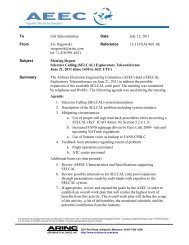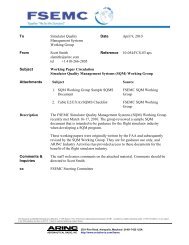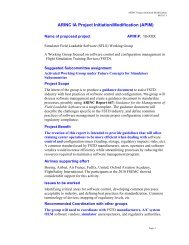(AGIE) Using Internet Protocols - Aviation Committees - AEEC - AMC
(AGIE) Using Internet Protocols - Aviation Committees - AEEC - AMC
(AGIE) Using Internet Protocols - Aviation Committees - AEEC - AMC
- No tags were found...
Create successful ePaper yourself
Turn your PDF publications into a flip-book with our unique Google optimized e-Paper software.
4.0 <strong>AGIE</strong> FUNCTIONAL SPECIFICATIONARINC PROJECT PAPER 830 – Page 294.2 ArchitectureThe <strong>AGIE</strong> based communication system is composed of a network of <strong>AGIE</strong> Clientinstantiations through which end-system (software) applications interface with thesystem and a network of <strong>AGIE</strong> server instantiations that manage the actualinformation exchange across the system. The functions of an <strong>AGIE</strong> client aredescribed below. The functions of <strong>AGIE</strong> servers are considerably more complex andare described in Section 4.6. Architecture describes <strong>AGIE</strong> nodes, both clients andservers, and their relationships defined by node definitions and end-to-end topologyconsiderations.COMMENTARYMessage implies “message push” or “message notifications.”COMMENTARYThe terms <strong>AGIE</strong> protocols and <strong>AGIE</strong> interfaces are used throughout thisdocument. <strong>AGIE</strong> protocols refer functional interfaces between <strong>AGIE</strong>components. These are primarily related to AMQP. <strong>AGIE</strong> interfaces are peerlevel inter-function communications using <strong>AGIE</strong> messages which areconsumed by <strong>AGIE</strong> functions. <strong>AGIE</strong> interface semantics are defined inSection 6. <strong>AGIE</strong> interface syntax is defined in Appendix D.4.2.1 <strong>AGIE</strong> ClientsThe <strong>AGIE</strong> client is an <strong>AGIE</strong> node that interacts between an end user application andan <strong>AGIE</strong> host server. The client provides <strong>AGIE</strong> services to the applications. Itinterfaces between applications and its host.COMMENTARYThe term “application” as used throughout the document usually means anexternal software based <strong>AGIE</strong> user. However, most often is can also be readas “<strong>AGIE</strong> function” or “function”, as <strong>AGIE</strong> infrastructure functions behave likeuser applications in regards to <strong>AGIE</strong> messaging. They however, oftenprovide their inputs directly in well formed and compressed formats and havespecial security handling provisionsThe client-application interfaces are defined as XML documents over an undefinedphysical interface via AMQP client layer. Physically, clients and applications maycommunicate via any method, such as inter-process communication (i.e., sockets),by function calls within software programs, or over LAN or IP networks. This is left toimplementation.<strong>AGIE</strong> defines a service layer application-client interface. This interface operates viaservice request on message originator side and via message notification/push onthe receiver side and may use application-to-application addressing via applicationIDs.Clients perform fragmentation and re-assembly of large data. A size limit for datatransfer is defined within a particular <strong>AGIE</strong> system implementation. Should a datafile be larger than this size, then the client fragments the file into smaller messages.This ensures the AMQP data transfers and internal memory constraints are notoverloaded. The destination client re-assembles the message fragments into a finalmessage for delivery. This requires care in implementation to minimize data lossand efficiency, where either the client has persistent storage or is highly available.










